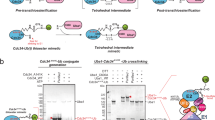Abstract
During ubiquitin ligation, an E2 conjugating enzyme receives ubiquitin from an E1 enzyme and then interacts with an E3 ligase to modify substrates. Competitive binding experiments with three human E2-E3 protein pairs show that the binding of E1s and of E3s to E2s are mutually exclusive. These results imply that polyubiquitination requires recycling of E2 for addition of successive ubiquitins to substrate.
This is a preview of subscription content, access via your institution
Access options
Subscribe to this journal
Receive 12 print issues and online access
$189.00 per year
only $15.75 per issue
Buy this article
- Purchase on Springer Link
- Instant access to full article PDF
Prices may be subject to local taxes which are calculated during checkout


Similar content being viewed by others
References
Huang, L. et al. Science 286, 1321–1326 (1999).
Zheng, N., Wang, P., Jeffrey, P.D. & Pavletich, N.P. Cell 102, 533–539 (2000).
Huang, D.T. et al. Mol. Cell 17, 341–350 (2005).
Kuhlman, B. et al. Science 302, 1364–1368 (2003).
Pickart, C.M. & Eddins, M.J. Biochim. Biophys. Acta 1695, 55–72 (2004).
Hamilton, K.S. et al. Structure (Camb.) 9, 897–904 (2001).
Siepmann, T.J., Bohnsack, R.N., Tokgoz, Z., Baboshina, O.V. & Haas, A.L. J. Biol. Chem. 278, 9448–9457 (2003).
Kawakami, T. et al. EMBO J. 20, 4003–4012 (2001).
Carroll, C.W. & Morgan, D.O. Nat. Cell Biol. 4, 880–887 (2002).
Deffenbaugh, A.E. et al. Cell 114, 611–622 (2003).
Acknowledgements
We thank P. Howley and J. Huibregtse for clones of the E6AP-HECT domain and UbcH7. B.K. acknowledges funding from the US National Institutes of Health (NIH), the Searle Scholar's Program and the Beckman Foundation. B.A.S. acknowledges funding from American Lebanese Syrian Associated Charities (ALSAC), the NIH (P30CA21765, R01GM69530), the Philip and Elizabeth Gross Foundation, the Beckman Foundation and the Pew Scholar's Program. D.M.D. acknowledges support from the American Cancer Society.
Author information
Authors and Affiliations
Corresponding author
Ethics declarations
Competing interests
The authors declare no competing financial interests.
Supplementary information
Supplementary Fig. 1
Enhanced affinity UbcH7–E6AP-HECT pair inhibits E1-mediated UbcH7 transthiolation at lower E6AP-HECT concentrations. (PDF 76 kb)
Supplementary Fig. 2
Kinetics of E1-mediated UbcH7–32P-ubiquitin formation in the presence and absence of high concentrations of E6AP-HECT. (PDF 188 kb)
Supplementary Table 1
Measured dissociation and inhibition constants for wild type and mutant UbcH7-E6AP-HECT interactions. (PDF 28 kb)
Rights and permissions
About this article
Cite this article
Eletr, Z., Huang, D., Duda, D. et al. E2 conjugating enzymes must disengage from their E1 enzymes before E3-dependent ubiquitin and ubiquitin-like transfer. Nat Struct Mol Biol 12, 933–934 (2005). https://doi.org/10.1038/nsmb984
Received:
Accepted:
Published:
Issue Date:
DOI: https://doi.org/10.1038/nsmb984
This article is cited by
-
Activity-based profiling of cullin–RING E3 networks by conformation-specific probes
Nature Chemical Biology (2023)
-
Clathrin light chain A drives selective myosin VI recruitment to clathrin-coated pits under membrane tension
Nature Communications (2019)
-
Using proteomics to identify ubiquitin ligase–substrate pairs: how novel methods may unveil therapeutic targets for neurodegenerative diseases
Cellular and Molecular Life Sciences (2019)
-
Regulating the human HECT E3 ligases
Cellular and Molecular Life Sciences (2018)
-
Oligomerization-primed coiled-coil domain interaction with Ubc13 confers processivity to TRAF6 ubiquitin ligase activity
Nature Communications (2017)



